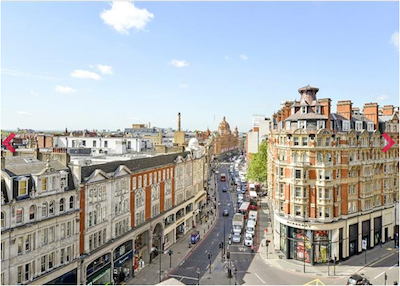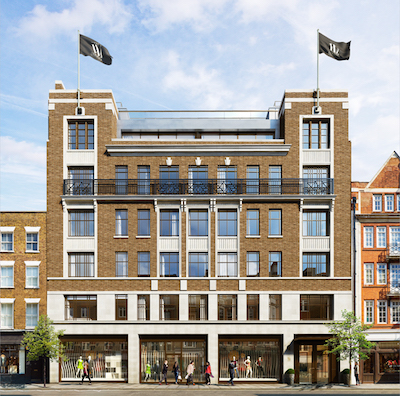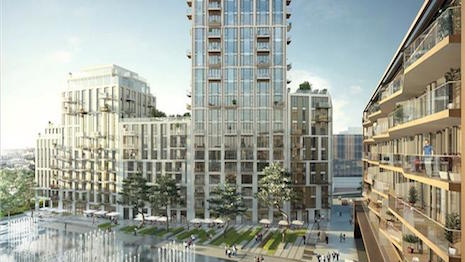After a period of strong growth, development land prices in London have returned to 2014 levels, according to a report by Knight Frank.
Prime Central London, urban Brownfield and English Greenfield land have all seen prices decrease in the second-quarter of 2016. The impact of stamp duty is making itself clearly visible, as higher-priced areas are seeing skeptical buyers refuse to meet high demands and drive prices down.
"We are seeing a softening in the market, but the problem is [the market] has a huge problem with supply," said Ian Marris, joint head of residential development at Knight Frank. "For a number of years we’ve been under-providing in terms of housing stock, and we don’t see that structural problem changing in the short term."
Under construction
Greenfield developments fell 2.3 percent from April 1 to June 30, bringing the 12-month decrease to 3.8 percent. Brownfield developments also fell, with the 1.1 percent decrease potentially signaling a reverse of the 9.1 percent growth over the last year.

One Hyde Park, London view
In Central London, contraction is even more notable. Prices fell for the third consecutive quarter, this time by 6.9 percent, to bring average annual values down 9.4 percent.
The slowdown is attributable to recent stamp duty laws demanding an extra 3 percent on high-priced homes and on the high cost of construction. With construction costs in London increasing, buyers are reticent to make higher bids, knowing that expenses will continue to flare in the development stages.
After plummeting during the recession, construction costs returned to baseline levels in 2010 but after climbing through 2013, they are now more than 50 percent more expensive with no sign of reversing. With such costs remaining high, bidders are recouping their expenses in the form of discounted land.
Developers did not report a slowdown in the days and weeks leading to the European Union referendum, as a supply-and-demand imbalance continues to encourage business.
Further from the city center as prices decrease, the burden of stamp duty also lessens, which mitigates price decreases in those areas.

Marylebone High Street in London
London has been fighting off supply problems for years, with the issue recently catching up. That structural problem is unlikely to change in the short term, though Brexit may lead developers to make impactful changes.
Knight Frank has also observed pricing taking place based on a comparative generic basis rather than on a case-by-case basis. The result has been consistent pricing for higher quality with prices slipping when the same standards are not met.
These patterns suggest a market in the process of finding a new equilibrium after a period of prolonged growth and a series of political and economic changes, from Brexit to the high taxes that the current government is implementing.
Past its prime?
Even as prices fall, value-minded consumers are flocking to the country, where the relative burdens of stamp duty and the price per square foot of land are both smaller.
Prime Central London real estate prices are falling, but buyers are still looking to the country, according to a report from The Buying Solution, Knight Frank’s independent buying consultancy.
"The Buying Solution Insight Report" shows growth has declined from 8.1 percent to -0.6 percent in the two years to June 2016, with sellers reducing prices by 10 percent or more to counter transaction costs, including recent stamp duty implementations. Nevertheless, value-minded consumers are diverging from the city center to find larger homes for lower prices (see story).
A volatile economy and the increasing prospect of doing business of all kinds digitally are suppressing commercial real estate. With this development having no realistic chance of reversing any time soon, the value of land as a whole might decrease.
Commercial real estate values have already peaked in New York, according to the majority of professionals surveyed for Marks Paneth’s Gotham Commercial Real Estate Monitor.
In just three months, the share of executives expecting values to rise has dropped from 43 percent to 31 percent, with nearly a fifth predicting a downturn in prices. The economy, new laws and even the growth of digital shopping all could play a role in future drops in New York commercial real estate (see story).
"I think the implications of the taxation regimes of the current government, and particularly the stamp duty, had a more profound effect than Brexit at the moment," Mr. Marris said. "The problem we have with Brexit right now is nobody really understands its implications.
"We don’t really know what it means," he said. "It undoubtedly means the U.K. will come out of the E.U., but whatever impact it has on markets is the question mark. And that’s the main issue, as to what impact it will have and what the financial services will be."
{"ct":"Mghe9NAvfXpCSWF8JtX1lb98wO43PtTR\/IBdRkPhP5x4iDFTyFEmm0zoIvq0rIb85pUlbfsMTC04OZN2DPdCxseY8F4+7x2SQCJypIrgY7LCj50JoIAJw1NcLqmtq2arfG1SBwtVv6qnnzRel3HyOAmllAs17dQGAfrNMwL0GMiRaJ5agJUvOElwWWDqvAiu01XCKKZdlHAKzajupzrYmlQ0sY3FwolKOM6Pk+IiMUCegvn31LFao39MbY9vk81O01KFsxpoZnKLFSLDb3D\/xKrZzxXA\/+gDSePQ0+2yvy96WK6gsBAyhlXsik9aNvmXdXacmLmJuSHv+vt6hXBaWyWc\/qpFMlC71D7eymEplUkK88qi4IhLpWozacpusz8liGuoVhAGwYpQ+fNf7V7oURvU5vrvSyRYGDJnxCNsyVcEZec28KRM8sPGboiLb8qzgg1QIUtzTCv211OPUaT7cqNQSbyFHwhX5LfsQxooCzuN7ujLEVT33xgLgO8q\/y0kyFunhq8FAcCJ4rfcBulAAZToi9C8r5FEN6D4uMhCbSmJ9yAe9lhVw6QB9Lq5bfMvktAAgOGtEgZE2wZWzG3MXwAl2WNEWN5u9HQ75uIjBXocWtdd8PhgQwTaZ6QiDc57C\/s8nXPU0Tw+HYJ7YwpF1CKfqJG6eLOFRp4PO0Ybigld08sWaTrcDaVWVBRomD76242DaIg7UwowygWCIO\/ktfttncappGHu8Mrrenow0pUPY1wACnDMXA+bEVo8zsrZ9UE8Q25lmYMZVe\/pVc3hOXTpapX3VZLITGHVALptwJw1I1zot0tVBZ3gZggnPnYwhUc5Hv+\/oDj9XSX+s9YUeddytyYN+xMMqkB1ddH140wZIFj63u7ReWTA9I4z9AK44Nj32cg4fB6Be5zazv45dKtoFYGU3Qz2Nuigto25lIJJ7Wpxxpnl1RSz6pUa2VHX+4rzlSTqEEryzQAc6IkAaY9UmSH7oN8GXKr5RqsN1cgrShqNNIncaUQ6dFbIW+DTLu4Nh\/+TXXCILrHKodKKjUpnr0PMxefts6XCI8nAQtsGVB64WWfuribNpLN1STAVK4FluguOWy\/f36b8zgVo\/V0Y+Kzldmrok++Bvut2mUePAXi+G2H9USiBiteOnQbka+sQduOP8\/O6luMeDjluctBQI2Ui4Z0IZGJRjGvpYeFdLqBU9qOCJaP94xJnc+6wFPQZTGgLdW+QciXemPv9s0nHhlECMQ9unFilHp0w+bqTPSlOFhw6Wmdc\/VGHDHlhZ5HBHdNnl4WszpSHmfVe16NmSZar9fuW4F8qqqsZlNcfn4DgzdpzmboXmSxQ8c+R8tpgScBmruILU+O23qvvW5v2SJRB8FdOdVX7bdhcs1pu+XXWrL7D5glGVysdbZav\/Rf20+gFo+Cpc080oKCloV9qg2STBEheNscz5pIDvySn02XNzZVV72U6QgYbNqXIQCKEFDwXPXXHDx13PAz9Vwq\/+bqQpdimTvEbj+MFgFQzJcT2k8sc4eEIN9mTfZ2pVlgP3WzPJmJeFx24r4aegCaGWBCZJ6UntQ1OTnGxa36yZksJtojnDpSTUMg7R9G33BWSg0O1iSGAcHHdrQOdoUguWfTVs1egTgWVIaDfAyDf0ky\/uvQAz9V2kIEx\/KVtgJfraS9LYd02TbG9\/+mQrdUqUjCw87HVTByEYfLHbTfxfcBnGA4cvXBXbrKDkyRaQcog2xsVliDYAWsmGkhflmc+Sqv6RFTW1fE2AUCv1+GrWL87Tg89l6uYY1VIB31me85lHq1t5xKGFAm3YeZq2KgjFRT5+nXSw2TpYyFfD\/d4lnBE00gAqTbVUkBN4VqQneV61BpynkqSq1+9ZUUxxuTlFdvQq+\/L0qF61ayYWsaw0ea+IpPKrfaMTDAz0ZjTbxiHZMhOqbro\/C8RZL5IMjrag5lw1jHBBSJoqlJzmzLU+1DGJjnoux6jDFMaaM8GO\/Bsx+tPF0psSW62RTuPa1tljw2ldv72E2oMergA2xdHXwWj0tyaCF50xR6YIfuWGVR9MAcTveGUUF4ViRy7YzSgK7857zTdXVo5GuVlPbkWxnpgvid7weEIRfZ+g3QyEheVumfYVcwXLKt7JHXJ9ffPIlf66\/9nj9UM41G+PYJkFJ9v3FI2JZy0LMwMTX9mXRWY73F6ye5wC6CVgoDg+3L6sMsr467myWgeHLopz3iLdgTPdpvy88ktHxaYIPmuiaim++Dz4uyVgaZLJjaJ9SOUrkmTxgbRkIIEfJX\/uzOCUhA3zX0kJZ10yZJ+9crHNK7eMbkwBwsvpuK1C69p7O+I9evm3GMF7WH1h4SXqubVxGw1YfxGm2JLH\/lfEav\/A5+KIE15ulrwgmz+QRGJVlLBYjH4PS4LV8laGPYGUos478g2hFZRhSY7r0mtme0WMcoFYZWd68OJAaEkIsmqTWI3LY4QkJKYZPEvnnRudX2xaFIwqiVbnKFOCDST2Z7gzdkrBC3oWghcuLoaZA9bfSuei0C58J3B4t8vjJ722DXP1etSbv62O0R\/zXNQCPUEwIjcV7pAanssKPQqC\/fg6xuf9SDGAgjHdtVcp9kg7wKQejm3+60gEbbZnRCz\/9+RjMAhzecD6zFxHU5Y1RvBd71nan\/aUl7kOYxB9GkiL3by1pr1gmxzn8Ie0uZBjdp8gP41Gc4O5xkc3lZN37uoTv8nzHelHiWzkg1E7Mrz5uhqfmxzbebtYPIxAzQwUfd0IJoSGsg5N9iOQuom9dto3p3zB\/0B3gq84cZmO3I4W8+XVhVTAcvo3G3Cw2Y6ZE2Bx+OwHQ12hpMEutsE0fMxeKaUx0UgJYkYmy4NbMbm4rJP8ut\/uAWiKRKAIrHAt6srpHaB0seA0JYOKNQsWTzXSWlXH3UzmCeYUDkcPvMtlHVjspURUb4UmghAL29t9Mrj0l\/M3tlK7hrHOIzvS4tlPeX1U1RW6onpcGJaK5l0dCm0J37a2MsD0tuPsc4jyCVinexVvliVKLS\/gECD9rTRIGtyF7kwZAQzdymub\/kKea1YJZPpSSkZsRB8tzHJ7kiDLyajGTfYHk3U5UFCzXJv6ZULxTMhq3o5aBB+jresg2w9qZg0fM91YJq+sVrAeZ3voSuek5gkI0fWaMxyG1JffHPtxsFvaczJoxjJzgeXlqoAwtSsn4i0U+pA8fb5KQuc7R1sEoUiGwc9wamygq2IHOTOg3gdQQeQbf3aH2WM2iQys7kXcDF37uVOxMmWA9IYpEmDSpZz49ZjuJWGeQIGfQ+W9LGldxfRoXzlhb\/jDeyrQV5y1FmpiEB8sD4BAxKd4ZRv\/rV1FnfOIU\/PCPK9hth525THEFiyKFRASs+MBw5sh8xqLyd3h64Ur0ptwg1HcuO2YLs87EzQHa\/MZqNcNzQLeUjqR2lLkCcWROB4grd4BLwmWBksOWY1V9evzc\/0wMQzLkMySOvp9TeNblHhYP5MBA\/bqLpN2X67akbVST5kc3a7gs2FFOfTDjM\/MYNLeG3KeW9PbKf\/yhDN\/cBCKYHGnBDGPLWwUumPeylk5uDpaMl6Vu5x7gcccG2sq4zCY+KPHC2W1x0NFWsKOLnckg81Rhm0SFsAZcTIYwtEuR+fi1uoq6dzitArQ8ITAYbaqMSnXUAl9b+ubLM6dj8MyhUgjt6qXGkxm5sPXA9efhBE7NPmpVUJw6lvDcttf7homPaTgQzRPThz3gInjiF7SlJdvajSk03j0IFA20dsO3Kde45llzRjakKa91k52KlLCpBtD1J9L7r\/e4CELs6xQJ9qYl5m9hV5f6h5GQxNWv3zz86sh6TJ+Vc1hcMyqw889NdF0nh0DCWOgBRn9D8iWcaKx5bj0OYpovorhECaVySJLEJgpPmncPkdsXpeDDtOvcgrDN\/QGowl6VAKiObp0z8ypPjwAJ1kf8O6IgFL\/H6Mvj0\/nkTwoBupgqg7QyblASn7Kwo6fAyp+fCiMl8RpUt+LdjSCAfdQBFopA5dwNk7dk8QOs4nJpzyntp\/clBcdyB8EYaYG\/NeHG1lSdcK99EXA3dyDT95hnt4f6Ji3hYV2T2z3nRQEdyRHU9HJp739nvwdO2wikkVk7\/Lx8RJD\/zQtb8jj+VUR2l43MoOmTLx1moa7Hq0Gsbiz+ncnVkZrLFtzAaGPjiSPEFv9lBHV3xlT2pXrK0H5ninrbp8fAHo1le2Uvt+ZFlRQdj5wnxRIrm6Aw\/bfFavoqXbBbjh\/JINcsy7O4mn7tN+h8obkMbzJ3Sv5Kn87YKbgAXxAytF8llPAAdqn\/2vcVIx73tkAwW9uxYAQ4YalTDajSTbFaN\/jBNURotwhpb8BmUjrFrKYnpBcDc4SH1GwGWb8qpVw7J\/eZigt4+GsAK9qW5QLEQ+fWAmHV2EKIKRVI75y7t9Lx7\/+aneYfPrcdYQCZKcDeO\/LXqE0bvkkkBu46ogsEpKB2X4tCiEl3n0FO0503RFZS7h3p4ToAcoXeAmd\/rXUycFzX8DfjlGcwHJQfS1uZrluJar0\/dZ9QtGtecR12kfze21QgZya4wIIVOFznPII8v\/G66IVH98hZyB8rOsS+6phn\/+6bnVaqZupp9EdHo2olp3ag5EX7Ah25NQxjYHz+qLWrr33MbDdyOOxpKamakFrsgWpBIDo7deaJuLgAErvuwMB8PEjvtTqeSKDQ8RZRZzBHByIAocbF\/N8fLREOt07Z1jdycDDLaesOeExI+LA20gowGecTapjCBY1NYFkqv7EvI6xVUrNF5haT\/GF8cC8tcfz8brjcqLmUAxGdU5MGi8Rq\/mRYZN2KbDsXMLrIojNixf3TGEaHYpX53f+bZ5ZcSmZvWw9ICK+lBbTYURQaqvDTolD75kypMk3DS5nu5X8u+y0kSEqgE9v0ixy1DRYxVSoE3fm0O9kEgUeUy3eQVH\/IxQYxj4ynlBKJoxm2HStsEm1HXIqnXNK9M2fE7oR\/HpR125xkol3UQCX1URwXKoTud0FYAE+GS7vTA1+NYVHrS\/HTifx20h6LWwqwUtY3GepJ+EVvIR8DcNy35pjMDIsQyKB1FB3TvjfOKqImmi\/vNRPDRBoIOio0hSBGxwkYihFUNYGM3l4lFdiE6710kXVRgBPpLhKWd6D08T6BzVnc9bYaTgzRIS0WNQL4ckrAs4q9wTegsSrcz41uzdHjFgim3azYif41gU6vsR\/6b\/FSMfeMO8rcpgWqe97Ty85eP8oiWm30\/lTo0FKKzTYqURxc9irtKpgNZdvyIm6rqsT8KC7IWZIrLbkg4rc8D1VdKKDZGk5ve8xjaL4eVY7svO6aIuM+D\/85+RTbwEns\/kGdfG5cxunarcDoZIhrsmW7fKyqA7UtXMKLFdiNfhUJVrIZVuuZqR2bcmd1rLz959wrjurOz09ConBFfHru5w\/Mf3FCC\/8SOm0+gbK+2da+In\/XwZcEyq3LVLDJjK9poxU9Cdakl3HHmUB21QpKLwjmUyGGJouNgQuw0OEJheFiDy7pRSN4YuJKxDc7ygnCdlzPjUE8F\/YUL4F6zh0RLjuiE58QVQK+6engdvxFVpsuq3eiVq6NbE2xOE2u887FdhBJ5U0qpQYOWYnvpAfIJyLg0VbkYcWSse4Z8XXMdfinC\/88k5nd4402qgc7xgP\/36b5SB4\/+MF4Q2WSin2cFaknEDkIEZCYaleignkkxQiz8TIUC2Pp5RoXYYQ9g3tbtuaG+UtLVUB+9ANHNs6eyeGM8wOwB+OCACW5fQ86yN7a9ZL+UTxeYxI9+Kx7Lrrz87Fchgwj9gPauGTWUroVWUtldnHaQNAT76sfqpiufoTFW8Rdz2XITyz2VFI3694\/2BZ\/Wa0hvmfcquDH\/CqjG67YAT7huIewXDjkkpvBw+X\/K9sWL7KtO4cgxAXXXC4rQ5Q6guukjZYE6Xc35fakARX02x6skGfgmBW4Znm\/5HqTvM4fY+nCGOzrRKZ+s33lIutlx62WaO4WLoeSogxS03gTi+1tNUqQy1ZPADFTmgJrrNenj7yTQq4l8WEebU8hO9qmqlrcC8FNlEnsrE\/oPiIzV9dUrZlFcBEn7hp0uaLwlHbaaVNyns7vz8MH+xtwQRXEE8Rnp5dMDSt3rDeMoxy2f5LhXH98+BgJjtgSsr92Gz\/ENT\/z5xgeCZVwuD89jkZxTPsv4JWyNA3fGoaN4XVVsH59S5XWUGEipak2H+0TOcRxfwGCPXyHEbV8XbO5RgPo\/xssBqNFqThQBJPQ36rE+qABrZKOqLhjfctO0T2np8Oycaak8pvKtIC9HTLzKrNki5EpYmS5G98A1yQBg9Rg+yIk0yEbZc3QefzuLqoC7YwSIWsEjB1ThzAE83bvakUU4CN0SLTqEsoqcz5zFcPsNTT6YIi8bVYqskiPSDOa6Wlat9xi2KZbZMtw4I+7BpBX4lQKIwmX3QIRnnS4OCT9OZ1k1eQpN4wBmLVeVc\/TZ+scBU7lvLkmjKEv\/buHB8+NzM1T3eeXnFL5169qCr\/xvJpK7AY8BIA50UJxdW8Th43KDMQ9X5MKGkikSXzGn3l+RnDQe75UGOWyB6F2S7zAGLbo2owWS9T0VtdhfCcoQ3s9doKLQ\/0W0349753MMJGvOOLhnbxrPhyXBdmXujUISI5SEPELyywPkW0RuRVsE0ze5fx5i6hCo9gSNs4hVim4nqVoDULJykigAAnW2h6kEZxR6QjbTQd5+ENLo8zs0wbGagyJlTPsSqCCbNEXJHQorsZ53foCf6uPGhaDRcTiyGXcHF3Eirqq3\/WEMjU1JEt8RBM89TapJKPZAb1n6+9JrnMu8nP4yUcZ4DE4E2nvQHYylxgSWwQdS+pCPd1T5EFogl9yGumHYoHyijcElfRazstgoPrf8+NeRwLcePtCGK32AdQg6dlF5JVUN4UEoU9A\/ZLQb3aMFZGPQc4Q6nD\/fNKuP+jrMnlbeSOQv4CqyDlCe\/HuJuszyMXVW49vVn3MpdB\/JdBLXZfRH35KAGbRXN6XIpxlpAvcHttpJXsYPSkGa+bBEKwsPAL6URIJ6UPyjyLamm6lE\/tqRd2Ek1AVYNZ8TeJ8Uylz5nvPpKVq+7Chmt1a4VRzBwMudWFg9EU2h13gUTg20np+sb0EJcYABeAzpTq6DZneQX0tuAq0VD6XbQG7eNDacB648yvJ4n1AYQbDgroNcNl9mxO2JOj56vm2xTRz5522EGvZBwTQ++yHI2TqPzqFZBiubaUqoyJMh+kqJM\/NW0L142VN\/hczgBjnRhNyOC3Utg6cSlJaTkDHrThTqhFKlxnNdoezV2mjpAiyOfNU8mgSEAnRIgE6w9ecAYyhhjamk7GwUkTNpU8Npg3hE98Ojs+TLRo1CpQXXwTWF8tdI9C+UyVY2eKxaD5gtG77KkCKt1BnVSfnLmK9s5dxBrXxOjvdDKSvV3PxugsJj2RCrbiKFR7us72hG\/tRmU828P0if9zue8MF4q1n\/yp7\/MYKrE6RPPu9PDo9gZFmkVDUdb4nAhCkmcFG2TmK7lPf1SeSSYc0HFTpDNhJMHveDmrb3rdqLUpSVXtbaJVA+PCGnkyEdjLHo22vpRNgR7alI5b8cuGGnJRH2z4SguiJf0IKwVp89ZETVLYdpx9c7xtjtITC885N7OYEa9bc+bdLwWjvTn7APG48EdlKRcJUeKwwCEVVLYl6UMBnZ53PVZC9Pzb2HQIcNM60Io+35pvdy7NJRj10QXB5HXG8d+jVlMH2MxEcBHdJEkOqmvLBdvVMAbraSTulfE1SC47JJ9PG2dqHSP23TZgrtGCc58vXc7Ic+feOYqgLfDuOA53IsZAcKSJZEDexw7VmqOej78G+pxfhkLwQTTEYTd8xrqkfC69Tj04ZFD+1vewObExXz0oWWDUmqnmgosyqs\/K39QcO7FgPz+o4nritpQgl0xDIDpUlhrGrjcmAcfiBc4lI1\/jGZjnRGUxugXDF+vwtk5PxZ9qRkxxEG3+coSfCPe1A6uCrdkG7k4WkMHP2JJynNcXZGfiWFG6bbHfKx8+ynR65wLlJ+f8DJStFQpkcsH9vNtlo5X585OVBRZsN\/s3IDr3+FgQUAWU6X+RLdk65xwSkL20iOWeRsNhWiNwfmcENAZsUri6yk2yZ65UTBs5AyfsfJVtyr18kELQqbCvs44EGMUA+kkvGqRgisyHZEuM5oC4nGaHzgfQ\/YzS\/g40f0ELBuPqVnFvAQ3lQSDzGWpulZdJdB8+rJBdDEwY85L5y8MZt7PS1sdwPdUfQ6JEEAwW+7p9JH1v4Biq9Ph0BQaM+lCa9oqWwXpXqw\/at2+w+r8g3C7Rm7+\/ch1qj4xornhx9xry\/BrET1kfY5vhYkXEyp3qMZlhWTleFEyzQFto6gq\/EoYnJ8HyCCBjr2YGuV5yE7TrguEA2ZPjt2Y75JNPnf+N\/tpQOWlgKPa230WEKW9MHHltZWNeTwAmB4JMpni+LCMgKcZB5aSru3NOQsOmzlCy8ovy3rMzy5\/diFs9MCrPNAj37i9UY4qqr\/VjoSpD2BTyxHUXRydVx5qpwBNWQ0Tnf0ZnnMRs0jqGfzvpOFlkLDQddLDy9zzrJOMF+4P\/M8M1C7rTooLgZFO5ukfixaXBT0T02J8RX3vVGWNv78XnoROH+TQGSJs6\/X5fopHoZGWizEAnXXuKCUt230SqN8eyxqf\/DE=","iv":"8be9e0e15cbab600958264b53b0f9374","s":"06f0b66a7d6c50aa"}
